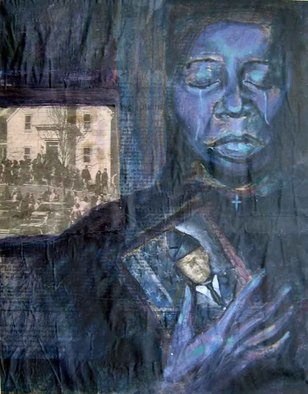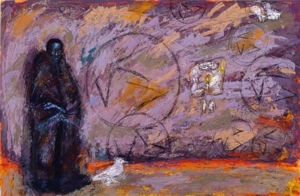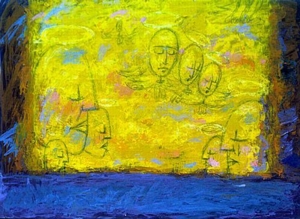 December 07
December 07
Against Mourning
Anne Goldman
 Jews are not the only people ravaged by memory. For African Americans, it is the long arm of slavery that holds back the living. “…[m]ama told me what they all lived through, and we were supposed to pass it down like that from generation to generation so we’d never forget,” the central character of Gayl Jones’ Corregidora explains. This novel tells the truth more convincingly than many testimonials. “Always their memories, but never my own,” blues singer Ursa muses, the insistent negation of the phrase an echo of the Jewish pledge against forgetting. Here a hysterectomy proves strangely restorative: prevented from “making generations,” Ursa conceives a life that sustains more than treachery. Want becomes wanting: in singing, she expresses desire as well as loneliness.
Jews are not the only people ravaged by memory. For African Americans, it is the long arm of slavery that holds back the living. “…[m]ama told me what they all lived through, and we were supposed to pass it down like that from generation to generation so we’d never forget,” the central character of Gayl Jones’ Corregidora explains. This novel tells the truth more convincingly than many testimonials. “Always their memories, but never my own,” blues singer Ursa muses, the insistent negation of the phrase an echo of the Jewish pledge against forgetting. Here a hysterectomy proves strangely restorative: prevented from “making generations,” Ursa conceives a life that sustains more than treachery. Want becomes wanting: in singing, she expresses desire as well as loneliness.
Utopian the novel is not. If it closes on a note of ambivalent promise, Jones does not jettison the past. Still, the book argues forcefully against the blind continuance of oral history when this becomes more disabling than recuperative. Recalling hurt repeats the injury: “We got to burn out what they put in our minds, like you burn out a wound,” her mother tells Ursa. “Except we got to keep what we need to bear witness. That scar that’s left to bear witness. We got to keep it visible as our blood.” Her relatives school her to continue this painful catechism, but Ursa refuses. Burn. Wound. Scar. What are you left with? Better to cut yourself away from your roots than be strangled by them. Jones invokes surgery to literalize this principle, but other novels offer parallel admonishments. The heroine of Octavia Butler’s Kindred escapes the antebellum South though she loses her right arm in the process. The central figure in Toni Morrison’s Beloved beats back the past each day only to be haunted by its specter every evening. But eventually Sethe learns too. “This is not,” Morrison concludes, “a story to pass on.”
The pronouncement is one Jewish Americans would do well to heed. Morrison’s character sacrifices the living memory of her child for “beloved,” the word chiseled in pink granite on her murdered daughter’s gravestone. The substitution calls attention to what we already know: too well tended, the practice of grief effaces the features of those we mourn. The massive stone of the monument pulverizes the traces of particular lives. While the children and grandchildren of Holocaust victims wish away the bitterness of their unwanted legacies, the rest of us rush to take on their burden, staring fixedly at images of the death camps as our family photographs fade to sepia.
We value what is called collective memory because it plays an important role in the preservation of our cultural life. “A people’s memory is history,” the advertisement for a Carolina oral history project announces. The phrasing sounds pleasing but its equation puzzles me, for the daydream of memory and the deliberate evocation of the past we know as history share little beyond their retrospective vantage. Chronicle can be revised, rejected, reconsidered. Memory is mostly fugitive. Its transience and its impermanence account for the wistful potency of exilic story, as well as the residue of anguish that underlies our efforts to call up images of the people and places we have lost. Still, the commandment to remember holds us captive. Nobel prizewinner and Auschwitz survivor Elie Wiesel routinely invokes its persuasive power. “Your presence here,” he told a group gathered at the tenth anniversary of the United States Holocaust Memorial Museum in 2003, “is our answer to their silent question. We have kept our promise. We have not forgotten you.”
 Can this vow offer anything more than rhetorical resolution? Perhaps it is the inevitable failure at its heart that accounts for the incantatory power of the phrase “never forget.” To insist on the vagaries of memory is not to suggest we stop telling stories to educate our children, nor to dismiss the public ceremonies by which we mark loss as a community. Nonetheless, it is important to recognize the difficulty implicit in testimony’s exchange. As conscientiously as we take in descriptions of atrocities, the teller tries to rid himself of this plague. The divide of feeling is deep. Out of guilt we insist upon passing down, not memory, but the emotional landscape that sustains its retelling. Yet this wellspring of feeling cannot simply be transferred. No matter how compelling the witness or sensitive the listener, I doubt it can be shared at all.
Can this vow offer anything more than rhetorical resolution? Perhaps it is the inevitable failure at its heart that accounts for the incantatory power of the phrase “never forget.” To insist on the vagaries of memory is not to suggest we stop telling stories to educate our children, nor to dismiss the public ceremonies by which we mark loss as a community. Nonetheless, it is important to recognize the difficulty implicit in testimony’s exchange. As conscientiously as we take in descriptions of atrocities, the teller tries to rid himself of this plague. The divide of feeling is deep. Out of guilt we insist upon passing down, not memory, but the emotional landscape that sustains its retelling. Yet this wellspring of feeling cannot simply be transferred. No matter how compelling the witness or sensitive the listener, I doubt it can be shared at all.
Primo Levi describes the urge to bear witness as compulsion rather than obligation in Se questo è un uomo, the memoir he wrote between 1945 and 1948, published here in 1961 as Survival in Auschwitz. To “tell our story to ‘the rest,’ to make ‘the rest’ participate” he explains in this account, is “an immediate and violent impulse, to the point of competing with our other elementary needs.” For the survivor, Levi argues, revisiting trauma is as likely to erode health as to enhance it. By turns sociological study, psychological exploration, and chronicle of habituation to the extremity of suffering, his book compels through its matter of fact exposition of the author’s ten months in the death camp. But Survival in Auschwitz rarely memorializes. Instead, it communicates to readers a rigorous effort to think through the Holocaust’s schema of violence, an understanding denied the prisoner—whose eyes, Levi comments in his 1986 study The Drowned and the Saved, remain “fixed to the ground by every single minute’s needs.”
A canny retelling of Dante’s Inferno, Survival in Auschwitz offers fable along with fact, a story whose familiarity helps connects us to the author’s experience. As Virgil leads Dante, so Levi guides us through the Hell of our time. By invoking the poet’s language he replaces “the hard cold German phrases” that assault him at Auschwitz with his own tongue. But retelling unwanted visions of the past to ensure others “participate” in his experience only thrusts the writer farther from those he longs to rejoin. Paradoxically, the world of the damned offers him a way back, the torments the medieval poet imagines the tool Levi uses to fathom the reality of the concentration camp, a place without earthly referent. In the same way, though we can never put ourselves in his shoes, we can approach Auschwitz by returning to that oldest divide, the threshold that separates the land of the living from what the author calls here “the house of the dead.”
But the “internal liberation” of the first recollection is only a temporary restorative. Levi admits the self-conflicted character of The Drowned and the Saved when he comments that the book “must be protected against itself” because it draws from memory, “a suspect source.” Or, as he muses from the vantage of a 1980 short story published in English in 2007 as “The Girl in the Book,” “It’s not true that memories stay fixed in the mind, frozen: they, too, go astray, like the body.” The more distant the recollection, the less likely it is to reproduce the integrity of the event. Levi’s apology is not disingenuous: there is a pallid quality to this book, which hovers at the gateway of the surreal world represented in Survival in Auschwitz. Despite its nightmare setting in the “lager,” a place so perversely fantastical as to seem impervious to cliché, The Drowned and the Saved is a gravid memorial with little emotional vitality. An amalgam of Levi’s own stories and “information gained from later readings” and “the stories of others,” the book hovers in a grey zone of emotional confusion. Leached of color, its voice speaks without timbre or accent in wan imitation of more urgent expression. Though Levi resists the consolatory gesture (the easy moralizing that distinguishes oppressor and oppressed in so many second- and third-generation accounts of the Holocaust), his words remain sluggish with sadness.
 If even the later work of one of our most gifted thinkers and writers must struggle to communicate, the scores of books and films that return us to the camps from the greater distance of time and person are as often distinguished by falseness of feeling as freshness of approach. The son of survivors, writer Melvin Jules Bukiet enumerates the task imposed upon the children with succinct comic bitterness: “It’s our job to tell the story, to cry ‘Never Forget!’ despite the fact that we can’t remember a thing.” Bukiet’s anger is as distinctive as his recalcitrance; more frequently, contemporary accounts describe without animating the past. Lacking the urgency that moves acts of witnessing such as Survival in Auschwitz, they murmur ritual devotions. Here is the survival of the memorializing genre for its own sake.
If even the later work of one of our most gifted thinkers and writers must struggle to communicate, the scores of books and films that return us to the camps from the greater distance of time and person are as often distinguished by falseness of feeling as freshness of approach. The son of survivors, writer Melvin Jules Bukiet enumerates the task imposed upon the children with succinct comic bitterness: “It’s our job to tell the story, to cry ‘Never Forget!’ despite the fact that we can’t remember a thing.” Bukiet’s anger is as distinctive as his recalcitrance; more frequently, contemporary accounts describe without animating the past. Lacking the urgency that moves acts of witnessing such as Survival in Auschwitz, they murmur ritual devotions. Here is the survival of the memorializing genre for its own sake.
Championing Wiesel’s memoir Night in a January 2006 New York Times essay, critic Michiko Kakutani defends against what should remain—yes, even here, at the site of the death camps—the first principle of any intellectual endeavor: the right to doubt. “When people assert that there is no ultimate historical reality,” she asserts, “an environment is created in which the testimony of a witness to the Holocaust … can actually be questioned.” This reverence runs counter to Levi’s skepticism, whose understanding of the created nature of memoir recalls Amos Oz’s description in A Tale of Love and Darkness. Oz sees the autobiographer as both archaeologist and architect, building a house of memory “out of old stones that he is digging out of the ruins.” For Levi too, compassion does not preclude critical judgment. “One must beware of oversimplification,” the author reminds readers in The Drowned and the Saved. “Every victim is to be mourned, and every survivor is to be helped and pitied, but not all their acts should be set forth as examples.”
But narratives about the suffering of concentration camp victims continue to proliferate, as if fighting for dominance with accounts of more recent genocides. There is something pathological in this unceasing abundance of representations, an obsessive-compulsive rehearsal of torture and degradation whose efforts to understand systemic violence diminish in effect as they increase in frequency. Our American eye has become macabre, indiscriminate in its demands to look upon the wreckage. Reanimations of the Holocaust play out on television alongside fictional dramas that reject crime in favor of the post-mortem and detectives, murderers, and victims cede the foreground to the dead weight of the corpse. We seem to have given up on feeling: treated to an incessant parade of commodities, we become enamored of the still thing. The camera lingers lovingly over the body that demands nothing from us save its own unresponsiveness.
With the exception of a handful of critics—Bernard Susser, Tim Cole, and the much-maligned Norman G. Finkelstein (whose 2000 The Holocaust Industry courageously if crudely addresses the politics of Holocaust compensation) among them—new scholarship does little to counter the indiscriminate repetition of this ruined vision. Invoking the problem of evil as truism and reducing the problem of history to the phrase “never forget,” critical studies fail as do popular efforts to recognize what drives them: not so much the desire to understand intensely painful feelings as the need to simulate such emotional states to remedy our collective numbness. Deprived of the quiet necessary for concentration by the distractions of modern life, anaesthetized by a surfeit of material comforts, we look to heightened states of feeling to produce awareness. Horror offers an emotional purity normal life refuses us. Because it is so clearly absent of reason, we assume that the world of the death camps must be correspondingly fuller in feeling, if only that of dread and despair.










